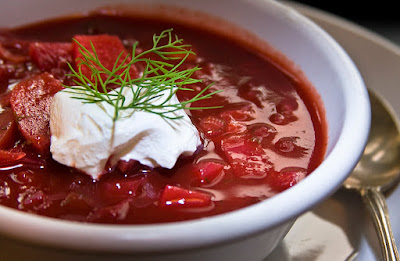Eating habits of Asia
Asia
Asia is the biggest continent of all and has definitely the biggest food variety I’ve ever seen ! Therefore I’ve had the idea to just take one example of North, East, South and West Asia. Cause, really, otherwise I would still sit here and write this blog next Christmas and no one wants that.North Asia: Russia
The history of Russian cuisine goes back many years. It changed several times mostly due to the influence of other countries and religion (much like Arabia) so new dishes and ingredients were added.A large part of Russian cuisine were preserved foods. Households had to preserve their food because of the cold weather that often lasted very long (like nine months or so).
The traditional dishes used to be made of a lot of grains, berries, vegetables, flour and fish. They were all available in the common families, whereas meat was most common for holidays or presented to rich families as culinary masterpieces.
To show one of these Traditional dishes: Borscht (don’t worry I haven’t heart of this before as well)
If I’m honest the description does not really make the soup very desirable but it’s one of Russia's most famous dishes for a reason. It’s full of meat and sautéed vegetables, including cabbage, carrots, onions and potatoes (told you it sounds strange).
Have you ever eaten it? Let me know in the comments.
https://en.m.wikipedia.org/wiki/Russian_cuisine
https://www.advantour.com/russia/cuisine/history.htm
https://www.tripsavvy.com/traditional-russian-foods-4173498
East Asia: Japan
First of all I want you all to give up on the idea that all Japanese eat sushi 24/7. Admit it, you all thought that at one point.A typical japan dish consists of a bowl of rise, miso soup, pickled vegetables and fish or meat.
- The Japanese rise is sticky and short-grained so it’s easier to eat with chopsticks.
- You know these things you always thought to be wizards wand. No never thought that...? Never? Anyway, back to the topic. The rice-cultivating techniques were actually passed on to Japan by Korea (as well as the Buddhism).
- I’m also pretty sure that most off you know noodle soups like ramen. Their very popular as well because their cheap and light (so have low calories): Thin egg noodles served in hot broth flavoured with miso (basically a normal soup with tofu pieces, vegetables or onions). On top: variety sliced ingredients like roast pork or bean sprouts...yummy..
- Because Japan is an island (at least it was last time I checked) their very proud of their seafood and therefore have a wide variety of everything that used to live in the sea (from fish to shells)
Rice with wobbly raw fish and ingredients like seaweed, vegetables, and tropical food. The exact styles of sushi varies greatly.
https://www.japan-zone.com/culture/food.shtml
https://oureverydaylife.com/the-history-of-asian-food-12207267.html
South Asia: India
Spicy, Spicy:Indian’s food culture is deeply influenced by many other countries and religions. Due to Hinduism, cows were used only for their milk and the Muslim influence changed the diets of many by introducing various meats for kebabs and curries.
It’s culinary roots were also planted by Persian-Arabian influences.
India is known for it’s use of herbs and spices. ginger; coriander, cordamon...believe me it’s an endless list.
If I’d ask you what kind of food you come up with that people eat in India, I’m pretty sure you’d say. CURRY.
Curry is very important part of the Indian food culture. It’s also said to be healthy and curb diabetes and obesity (do you think that’s true. Let me know in the comments below).
Interesting fact:
Vegetarianism was prevalent for thousands of years. Therefore 20-40% of India's population is vegetarian, although lamb and chicken are common in main dishes.
https://www.livescience.com/28634-indian-culture.html
https://oureverydaylife.com/the-history-of-asian-food-12207267.html
Weast Asia: Arabia
Arabia cuisines are strongly influenced by the climate as well as their religion. Just think about the Ramadan. One meal for dinner and one before dawn (I’d be starving). There are also foods that are forbidden due to the Islam, notable pork and wine. Anyway, this cuisines are extremely old, often centuries. Although they change slightly with ever generation.Meals are often large family affairs. Elderly people remember them as simple but adequate. They regularly ate at home because restaurants were seen as uncommon and somewhat improper. The day started with a simple breakfast after the dawn prayer. Today they are eaten later, more copious and elaborate.
The exact food culture is quite similar to the Indian and Japanese cuisine: spicy, chicken loving with a lot of rice and on special occasions, lamp.
https://www.everyculture.com/Sa-Th/Saudi-Arabia.html
(-Meike-)





Hey!
ReplyDeleteI just read your post about eating habits in Asia and noticed how different the food is in the countries.
It's good that you only referred
to four countries otherwise it would have become to confusing.
I was surprised hat 20-40% of India's population is vegeteria. I didn't know that.
To return to your question at the beginning. Yes I have eaten borsch before. Actually I eat it almost every week.
You've done well!
-Erika
Nicepost also check Italian restaurants in bandra
ReplyDelete